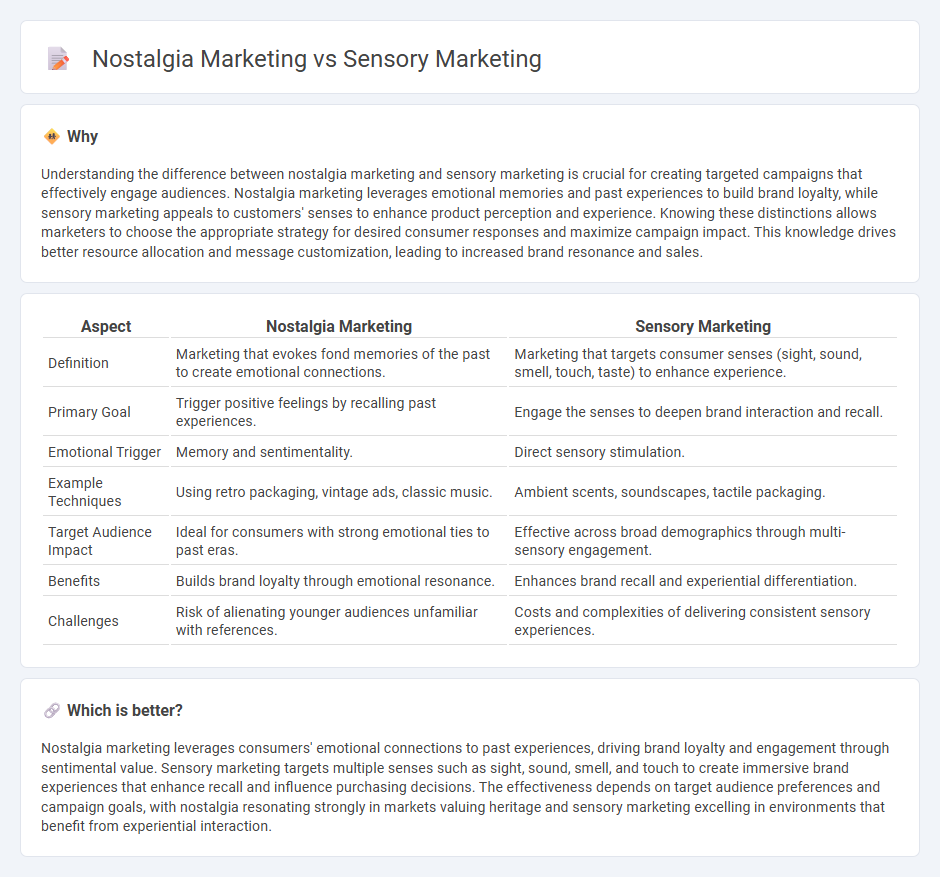
Nostalgia marketing taps into consumers' emotional memories by evoking past experiences, often using vintage imagery and themes to build brand loyalty and trigger positive associations. Sensory marketing focuses on engaging the five senses--sight, sound, smell, touch, and taste--to create immersive brand experiences that influence purchasing behavior. Explore how combining emotional and sensory strategies can enhance your marketing effectiveness.
Why it is important
Understanding the difference between nostalgia marketing and sensory marketing is crucial for creating targeted campaigns that effectively engage audiences. Nostalgia marketing leverages emotional memories and past experiences to build brand loyalty, while sensory marketing appeals to customers' senses to enhance product perception and experience. Knowing these distinctions allows marketers to choose the appropriate strategy for desired consumer responses and maximize campaign impact. This knowledge drives better resource allocation and message customization, leading to increased brand resonance and sales.
Comparison Table
| Aspect | Nostalgia Marketing | Sensory Marketing |
|---|---|---|
| Definition | Marketing that evokes fond memories of the past to create emotional connections. | Marketing that targets consumer senses (sight, sound, smell, touch, taste) to enhance experience. |
| Primary Goal | Trigger positive feelings by recalling past experiences. | Engage the senses to deepen brand interaction and recall. |
| Emotional Trigger | Memory and sentimentality. | Direct sensory stimulation. |
| Example Techniques | Using retro packaging, vintage ads, classic music. | Ambient scents, soundscapes, tactile packaging. |
| Target Audience Impact | Ideal for consumers with strong emotional ties to past eras. | Effective across broad demographics through multi-sensory engagement. |
| Benefits | Builds brand loyalty through emotional resonance. | Enhances brand recall and experiential differentiation. |
| Challenges | Risk of alienating younger audiences unfamiliar with references. | Costs and complexities of delivering consistent sensory experiences. |
Which is better?
Nostalgia marketing leverages consumers' emotional connections to past experiences, driving brand loyalty and engagement through sentimental value. Sensory marketing targets multiple senses such as sight, sound, smell, and touch to create immersive brand experiences that enhance recall and influence purchasing decisions. The effectiveness depends on target audience preferences and campaign goals, with nostalgia resonating strongly in markets valuing heritage and sensory marketing excelling in environments that benefit from experiential interaction.
Connection
Nostalgia marketing leverages consumers' emotional connections to past experiences by evoking memories through sensory cues such as sounds, scents, and visuals that trigger a sense of familiarity and comfort. Sensory marketing enhances these emotional responses by engaging multiple senses to create immersive brand experiences that deepen consumer attachment and influence purchasing behavior. Together, they increase brand loyalty by stimulating subconscious emotional reactions tied to nostalgic memories.
Key Terms
**Sensory Marketing:**
Sensory marketing engages the five senses--sight, sound, touch, taste, and smell--to create memorable consumer experiences and enhance brand loyalty. Brands employing sensory marketing often use tactile packaging, appealing visuals, ambient scents, and soundscapes to influence purchasing decisions and emotional connections. Explore more about how sensory marketing strategies can transform consumer interactions and drive sales.
Multisensory Experience
Sensory marketing engages multiple senses such as sight, sound, touch, taste, and smell to create immersive brand experiences that enhance consumer emotional connection and recall. Nostalgia marketing leverages past memories and emotions to evoke comfort and familiarity, often integrating multisensory cues to deepen the sense of reminiscence. Explore how combining multisensory experiences with nostalgia marketing can elevate brand loyalty and consumer engagement.
Sensory Branding
Sensory branding leverages multi-sensory experiences--such as sight, sound, touch, taste, and smell--to create emotional connections and enhance brand recall, making it a core strategy in sensory marketing. Unlike nostalgia marketing, which evokes past memories and emotions, sensory marketing engages the present moment through immersive stimuli to influence consumer behavior. Explore how sensory branding techniques amplify brand loyalty and drive sales through experiential marketing.
Source and External Links
Unlock Sensory Marketing: What it is and Why it Works - Glion - Sensory marketing uses techniques that engage customers through their five senses--sight, sound, touch, smell, and taste--to create deeper emotional connections and memorable brand experiences, exemplified by companies like Apple and Starbucks.
The Rise of Sensory Marketing: Why Brands Are Making You ... - Sensory marketing is evolving through immersive multisensory digital experiences and AI-powered personalization, enhancing how brands emotionally connect by engaging multiple senses even online.
Sensory Marketing | How Brands Use the 5 Senses - Promodo - By stimulating all five senses simultaneously, sensory marketing creates reflex associations and emotional bonds with brands, with statistics showing that a large share of consumers seek and remember multisensory brand engagement.
 dowidth.com
dowidth.com